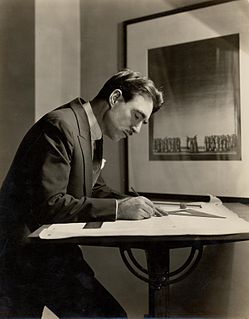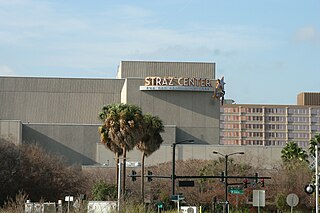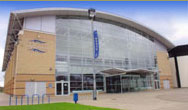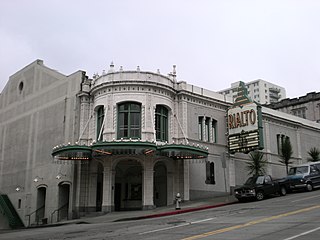
A black box theater is a simple performance space, that varies in size, and is usually a square room with black walls and a flat floor. The simplicity of the space is used to create a flexible stage and audience interaction. The black box is a relatively recent innovation in theatre.

Stagecraft is the technical aspect of theatrical, film, and video production. It includes constructing and rigging scenery; hanging and focusing of lighting; design and procurement of costumes; make-up; stage management; audio engineering; and procurement of props. Stagecraft is distinct from the wider umbrella term of scenography. Considered a technical rather than an artistic field, it is primarily the practical implementation of a scenic designer's artistic vision.

A safety curtain is a fire safety precaution used in large proscenium theatres. It is usually a heavy fibreglass or iron curtain located immediately behind the proscenium arch. Asbestos-based materials were originally used to manufacture the curtain, before the dangers of asbestos were widely publicized. The safety curtain is sometimes referred to as an iron in British theatres, regardless of the actual construction material.
Running crew, run crew or stage crew, is a collective term used in theatre to describe the members of the technical crew who supervise and operate ("run") the various technical aspects of the production during a performance. While the "technical crew" includes all persons other than performers involved with the production, such as those who build and take down the sets and place the lighting, the term "running crew" is generally limited to those who work during an actual performance.

In theatre and performing arts, the stage is a designated space for the performance of productions. The stage serves as a space for actors or performers and a focal point for the members of the audience. As an architectural feature, the stage may consist of a platform or series of platforms. In some cases, these may be temporary or adjustable but in theaters and other buildings devoted to such productions, the stage is often a permanent feature.

A theater, theatre or playhouse, is a structure where theatrical works or plays are performed, or other performances such as musical concerts may be produced. While a theater is not required for performance, a theater serves to define the performance and audience spaces. The facility is traditionally organized to provide support areas for performers, the technical crew and the audience members.

In the performing arts, front of house (FOH) is the part of a performance venue that is open to the public. In theatres and live music venues, it consists of the auditorium and foyers, as opposed to the stage and backstage areas. In a theatre, the front of house manager is responsible for ticket sales, refreshments, and making sure the auditorium is set out properly.

A catwalk is an elevated service platform from which many of the technical functions of a theater, such as lighting and sound, may be manipulated.
The RiverCenter for the Performing Arts is a modern performance space in Downtown Columbus, Georgia, United States.

The David A. Straz Jr. Center for the Performing Arts opened its doors as the Tampa Bay Performing Arts Center, Tampa, Florida in July 1987 and has welcomed more than 16 million guests. The venue was renamed in November 2009 to recognize the generous donation, the largest individual philanthropic gift ever made to a cultural institution in the Tampa Bay area, of financier David A. Straz, Jr.

Theater drapes and stage curtains are large pieces of cloth that are designed to mask backstage areas of a theater from spectators. They are designed for a variety of specific purposes and come in several types; many are made from black or other dark colored, light-absorbing material, and heavyweight velour is the current industry standard for these. Theater drapes represent a portion of any production's soft goods, a category which includes any cloth-based element of the stage or scenery.

Grimsby Auditorium is a theatre situated on Cromwell Road, in Grimsby, North East Lincolnshire. With a seated audience capacity of 1,200 the Grimsby Auditorium is the largest professional theatre in Lincolnshire, and one of the larger theatres in the East of England. Built in 1995, it is managed by the venues division of Ambassador Theatre Group on behalf of North East Lincolnshire Council.
A theatrical technician, is a person who operates technical equipment and systems in the performing arts and entertainment industry. In contrast to performers, this broad category contains all "unseen" theatrical personnel who practice stagecraft and are responsible for the logistic and production-related aspects of a performance including designers, operators, and supervisors. Many professional designers and technicians consider the diminutive "techie" to be offensive.

In theaters, a batten is a long metal pipe suspended above the stage or audience from which lighting fixtures, theatrical scenery, and theater drapes and stage curtains may be hung. Battens that are located above a stage can usually be lowered to the stage or raised into a fly tower above the stage by a fly system.

Valley Youth Theatre (VYT) is a community theatre located in Phoenix, Arizona. Established in 1989, VYT produces six mainstage shows each season, two of which are produced at the Herberger Theater Center.

The control booth, control room, lighting box, technical booth, tech booth, or just boothor the bio box
to theatre or television technicians is the area designated for the operation of technical equipment, and is sometimes the location of the deputy stage manager's (DSM) station as well as the lighting controls and sound board. Often one or two followspots are located in the booth as well. Generally it is an enclosed space with a large sliding window with a good view of the stage. In a proscenium theater, it is centered in the back of the house. It might be on the ground floor, but is sometimes placed at the balcony level.

The Rialto Theatre in Tacoma, Washington was built in 1918 to showcase movies. Its design reflects the affluence following World War I. It reflects the character of a palace and is the result of efforts by entrepreneur Henry T. Moore and Tacoma architect Roland E. Borhek. Designed to hold 1500 patrons and retail space. The two-and-a-half-story structure is in the historic downtown of Tacoma. The area has long been associated with theaters and entertainment. The theater is freestanding, with a dramatic view on an incline with a classical façade sheathed of glazed white terra cotta. Both the interior and exterior retain most of the original design of Roland E. Borhek. The theater has an auditorium, proscenium with stage, a relocated projection booth, balcony, lobby, and commercial space. It has been altered with the removal of the storefronts and marquee. On the inside, the lobby's decorative ceiling has been hidden and the concession areas expanded.
The following outline is provided as an overview of and topical guide to stagecraft:


















